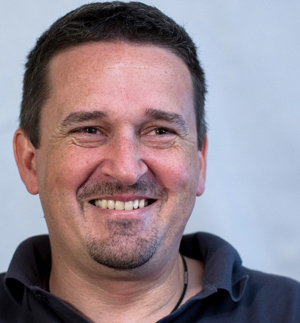4K Graphics: A Conversation with Vizrt’s Gerhard Lang

Gerhard Lang
ALEXANDRIA, VA.—Now that it’s a given that production is moving to 4K/UHD, the capability of 4K graphics systems is a hot topic. Sports and major events are the first to use such technology, and they have special needs that drive a lot of graphics development.
Then we can expect 4K virtual studios, which take graphic processing demand to the next level. To get a handle on these things, we spoke to Gerhard Lang, the chief engineering officer for Vizrt, on what we can expect for 4K graphics systems.
Lang joined Vizrt in 2000 as the head of R&D Austria. He has worked in the area of numerical methods applied to tunneling and mine safety, stereo photogrammetry, micro seismic event visualization, traffic analysis and simulations—projects that created large volumes of data and the need to visualize them in understandable ways. One of his current responsibilities is to drive engineering innovation across Vizrt’s product development.
BE Extra: Is there a big difference in making HD graphics vs. 4K/UHD graphics? What sort of computer hardware is needed to do real-time 4K graphics?
Lang: The difference is that the graphics can be even more detailed. Luckily for us, a new generation of the NVidia GPU alongside a new video I/O board from Matrox came out just in time for us to make full use of their processing power for 4K production. Because of these developments, graphics that were running close to real-time in HD can easily run on this hardware in 4K.
BE Extra: What are some of the special challenges for making 4K sports graphics? Has there been any particular use of 4K sports graphics that you thought was really well done?
The professional video industry's #1 source for news, trends and product and tech information. Sign up below.
Lang: There are no real special challenges. This is also what we hear from our customers. Everyone who has used our 4K Viz Engine solution in a sports production has said that the switchover was the least painful in the entire 4K production. Most of the graphics were re-used from HD. For example, the system has even been used as a downstream keyer in the 4K MotoGP (super bike racing) production in Silverstone, England.
BE Extra: What are a couple of the interesting special requests you’ve handled for big games/tournaments, such as the World Series, World Cup, Super Bowl, etc.? Is there anything coming up that you can give us a hint about?

Lang: Most of the productions for high-profile events like these were done without Vizrt personnel even on site. The switch from HD to 4K Viz Engine seems to be the easiest one when doing such a production. As usual, we cannot talk about what’s coming up— as you know, it’s just the nature of the broadcast industry.
BE Extra: What’s new with respect to virtual studios now that there’s more 4K production? Are there any particular implementations of 4K virtual studios that you’ve seen that impressed you?
Lang: We are geared up for a 4K virtual studio with one live input. Currently, total latency for 4K remains higher than it is in HD, but there are ongoing developments and improvements happening in this area. To date, no one has approached us for a 4K virtual studio, though maybe that day isn’t far off. 4K is far more interesting for outdoor events where you have to capture all that happens in one picture.
BE Extra: Interesting graphics are always done for the presidential elections in the U.S. Is there any interesting graphics presentation coming up for the 2016 election?
Lang: Again, unfortunately we are not allowed to discuss details at this time but we are working with many customers—both networks and local stations—for the U.S. elections.
BE Extra: What else should we know about 4K/UHD graphics for live production?
Lang: It’s a continual evolution of capabilities and flexibility. For example, Viz Engine sits at the core of the broadcast graphics workflow but also functions as a multi-channel video playout server for 4K and HD, while also allowing streaming IP video out. The same Viz Engine can be used for live 4K graphics today, a video playout server tomorrow or drive a video wall with both graphics and video the next day. It’s an exciting time. We excel in graphics and media asset management and we’ll continue in this role.
Bob Kovacs is the former Technology Editor for TV Tech and editor of Government Video. He is a long-time video engineer and writer, who now works as a video producer for a government agency. In 2020, Kovacs won several awards as the editor and co-producer of the short film "Rendezvous."

